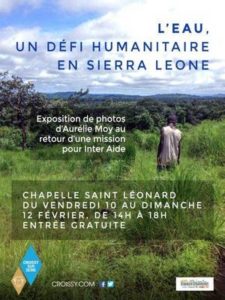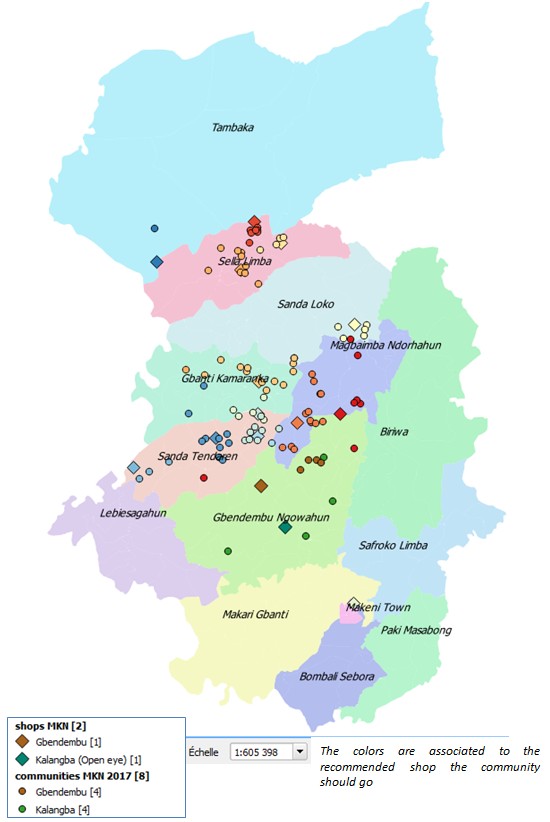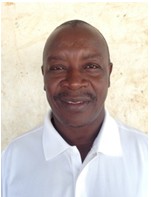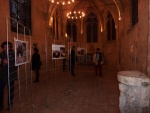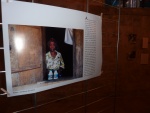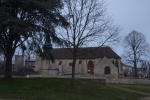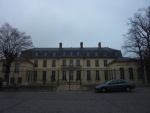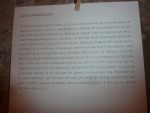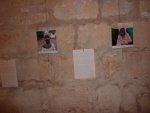Aurélie and team visited all shops and communities, here is an extract of the interview conducted with in september 2016 with the community of Kamalo Lol …
Inter Aide – Good morning everybody and thank you for taking time with us. We are workers from Inter Aide and we came to visit you this morning to learn a bit more about your water business. First, could you introduce your village: how many people live there, how many pots does it represent, how many houses…?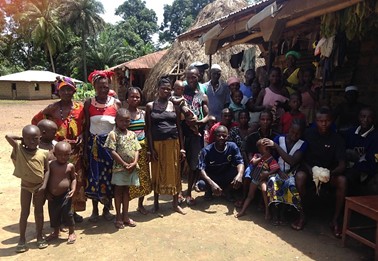
Chief – Thank you for coming. This is Kamalo Lol community, Sakuma section. The number of people in the village is 70. 14 pots. 7 houses.
IA – Thank you. When did you start this bleach business? How did you hear about it for the first time?
Secretary – checking in his notebook – It has been 3 years now since we started. Inter Aide came to talk to us about this bleach solution. That’s why we started, but we did not know bleach before. Now we know that the “medicine” will kill the germs in the water. And since we started, after the first week of adaptation of our systems, health in the village is much better. Before, we used to have a lot of stomach aches, diarrhoea… now it has been a while since we did not send a child to hospital because of diarrhoea. We tell God thank you for that!
IA – So now, everybody drinks chlorinated water in the community? Is there not some reluctant people?
Chairman – Everybody drinks it, from the youngest child to the oldest pa!
IA – And what about the taste of chlorine in water?
Random villager – It was only hard at the beginning. We needed a few time to get used to it, but now it is fine, we like it. Taste is like “packet water”.
IA – Who is managing this bleach business for the community?
Chairman – We have a water committee for that. We have elected the members ourselves. The women chose the women (Chairlady and female chlorinators), the men chose the men (Chairman and male chlorinators).
IA – Could you introduce those water committee members? Did some members change from the beginning?
Chairman – No, nobody ever changed. We chose the people who would stay in the village and do the job seriously. I am the Chairman, I am responsible for taking step against defaulters and giving some advice to the committee. This is the Chairlady, she keeps the money from the contributions. This is the secretary; he has a book in which he writes all the contributions and the purchases of medicine. Those two men and those two women are the chlorinators. They do the treatment of water for everybody.
IA – Did you receive some material by IA when you started?
Chlorinator – Yes, we received two kits, and for each kit we bought one bottle of chlorine. Two chlorinators go to take the kit in their house and show us the material: 1 bucket, 1 white cloth, 2 syringes, 1 funnel, 1 bleach bottle per kit. And we also received 14 five gallons containers and 14 cups, one for each pot.
IA – How much did you pay for this?
Chairman – The total cost of the chlorination kit is 45,000 Le [NDLR: about 6 EUR], so it makes 90,000 Le for 2 chlorination kit. And each container and cup cost 13,000 Le. But we had an arrangement with Inter Aide: we paid only 25% of the total cost, and Inter Aide contributed for the remaining 75%. So each pot contributed 5,000 Le to reach 68,000 Le. We were in charge of organizing this contribution, and when we were ready, we called Inter Aide, they came to collect the money and then came back to give us the material.
IA, showing the material – The status of the material is good. Is this the material that you received from Inter Aide, or did you have to buy some new ones because it was lost or damaged?
Chlorinator – Yes, we changed the clothes once because they were damaged. We found new ones on the market in Makeni for 7,000 Le each [NDLR: about 1 EUR]. We also had to buy new syringes because children had spoiled them. We found new ones in Kamaranka for 1,000 Le each [NDLR: about 0.15 EUR]. And we also regularly buy new chlorine bottles.
IA – The cloth is very clean…
Chlorinator – Because we laundry it after each use!
IA – May we see where you store the bucket?
Chlorinator – No problem. I keep it in my room, on a table elevated from the ground so that the smaller children can’t reach it.
IA – And which kind of training did you receive from Inter Aide? Somebody can explain us?
Chlorinator – Yes, I can explain. When you have fetched water from the stream, first you wash your hands properly with soap. If you don’t have soap, you can use ashes. You also wash the bucket and the cup. You filter water into the bucket through the white cloth. The woman holds the cloth while the man turns the container. After that, you turn the water back into the container with the funnel. Then you take the syringe, you pull chlorine. 2 mL for each five gallon. You put the medicine in the container, you shake the container, put it on top of a chair or a table and wait for 30 minutes. After 30 minutes, you can drink it. After 2 days, you can’t drink it anymore: you have to use it for another purpose and treat a new one. They also told us about diarrhoea, hand washing, latrines… Everything is explained on the posters pasted on this wall.
IA – Good. And who received the training? Only the four of you?
Chairman – No, everybody witnessed the training. They are the ones who know the best, but everybody in the community has an idea about the treatment.
IA – And how do you organize for doing the treatment for everybody?
Chlorinator – We do it in the morning, every two days. The village is shared into two parts. When people have fetched water from the stream, each part gathers together in one place of the village, and everybody do it together. But the consumption depends on the size of the pot: if one pot has many members and finishes its water before the end of the 2 days, we can go house to house to do the treatment. In dry season also, water consumption is higher.
IA – Is it always the same persons doing the treatment?
Chlorinator – Yes, always the same chlorinators. Every house relies on us for doing it.
IA – And do you receive money for doing this job for the community?
Chlorinator – No! It is a job for well body, not for money. It is a voluntary job for the community.
IA – And how do you manage if one of the chlorinators is absent one day, because he has to travel or doesn’t feel well?
Chairlady – We can always find someone to assist. I am able to assist the chlorinator if one is absent, or even the pot owner can wash his hands and assist the chlorinator. But it seldom happens. The chlorinators take their responsibility seriously.
IA – Does it sometimes happen that one day you have to leave early and you don’t have time to do the treatment?
Chlorinator – No, it never happens. Water treatment is my priority before doing anything else.
IA – And which water did you drink when you go to work on the farm?
Random man – We take small containers (1 gallon) of treated water with us on the farm. If we are many to work together in the same place, we can even take a 5 gallons container. We always do the treatment before going to the farm and nobody leaves the village without treated water.
IA – And this chlorinated water, for which purposes except drinking do you use it?
Random woman – For drinking only! Except after two days: then we use it for cooking, washing…
IA – How do you organize when the chlorine is nearly finished?
Secretary – When the bottles are almost empty, the chlorinators inform us and we take money from the contributions to go buy new ones. We buy by Umoro Soll at Kamaranka, 2 bottles each time.
IA – Did you know Umoro’s shop before Inter Aide gave you his contact for the chlorine?
Random villager – Yes, we already knew it, but we seldom went there for purchases.
IA –How often do you have to buy new bottles? When did you buy a bottle last time?
Secretary, checking in his book – We bought the last bottles two weeks ago. Two bottles last 2 to 3 months in average for the village, and it is pretty stable.
IA – Who is responsible for the purchases? How do you manage to go there?
Chairman – I am responsible for going there for the purchase. It is 4 miles away from here; it takes me about 2 hours to go by foot, 2 hours to come back. We also sometimes send the children because it is on their way to school. They use the card that Inter Aide gave us so that Umoro knows the purpose of their visit.
IA – Have you ever had any issue with the shop in Kamaranka? For example, you needed to buy chlorine but the shop was closed, or they had shortage?
Chairman – Yes, it happened a few times, but when Umoro is not around most of the time he comes back later during the day. When there is shortage, it never lasts more than a few days also. And if we really need chlorine as an emergency, we can also go to another shop in Masactaba junction.
IA – How much does one bottle cost?
Chairman – One bottle costs 6,000 Le [NDLR: about 1 EUR], but Umoro informed us that the price may increase soon.
IA – And how do you manage to find money for this?
Secretary – We organize monthly money contributions at the community level. Each pot gives 500 Le [NDLR: about 0.07 EUR], which makes 7,000 Le each month, and at the end of the two months we have enough money to buy two bottles and 2,000 Le money balance. We also use those money contributions to buy new material (white cloth and syringes). If we have enough money balance, it sometimes happens that we skip the contribution for one month.
IA – Who collects the money?
Secretary – I do, sometimes assisted by the Chairlady. And at the same time I fulfil the notebook. Look at it.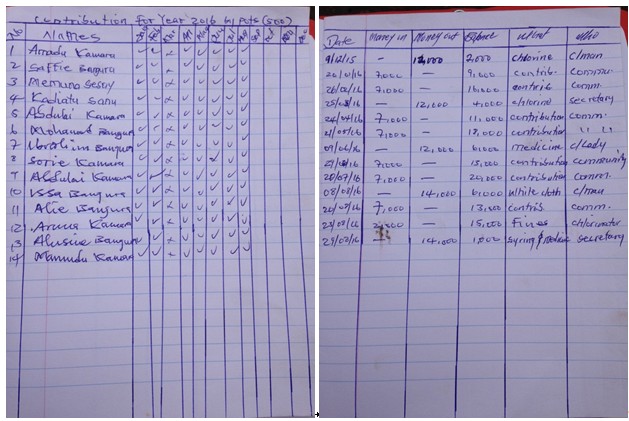
IA – Do you sometimes have issues among the community, with people who don’t want to pay for this bleach business, or are not able to pay?
Chief – Nobody is reluctant to pay for this, it is an agreement among the community and I make sure that everybody respects the law. It is a life business and everybody wants well body. If one contributor is unable to pay once, somebody will loan money and this person will refund later.
IA – Is it possible to see the water point where you fetch water for drinking?
Everybody – No problem.
We go by foot to the water point. It takes 4 minutes to reach it.
IA – This is where you fetch water for drinking? What about for cooking and washing?
Secretary – We use the same stream, but we go up for drinking, down for washing.
IA – And before Inter Aide’s intervention, you used to drink directly this water?
Secretary – Yes, directly! No filtration, no treatment…
IA – Is this stream dry during dry season?
Secretary – Yes, it gets dry around March, until June. Then we go to another point, much further!
IA – And do you use other water sources?
Secretary – Yes, during rainy season we collect rain water, and we treat it with medicine exactly the same way as stream water. And when we travel to big cities, we have to buy packet water, but it is very expensive.
IA – And do you drink palm wine?
Secretary, laughs – Not everybody, but some of us do. And they don’t do it for water!
IA – And are you globally satisfied with this bleach solution to get safe water?
Secretary – Well, we really struggle during dry season to find water, so we would appreciate a well. But until there, we will continue using this medicine as long as it is available in the shop, because we know that this water will protect us.




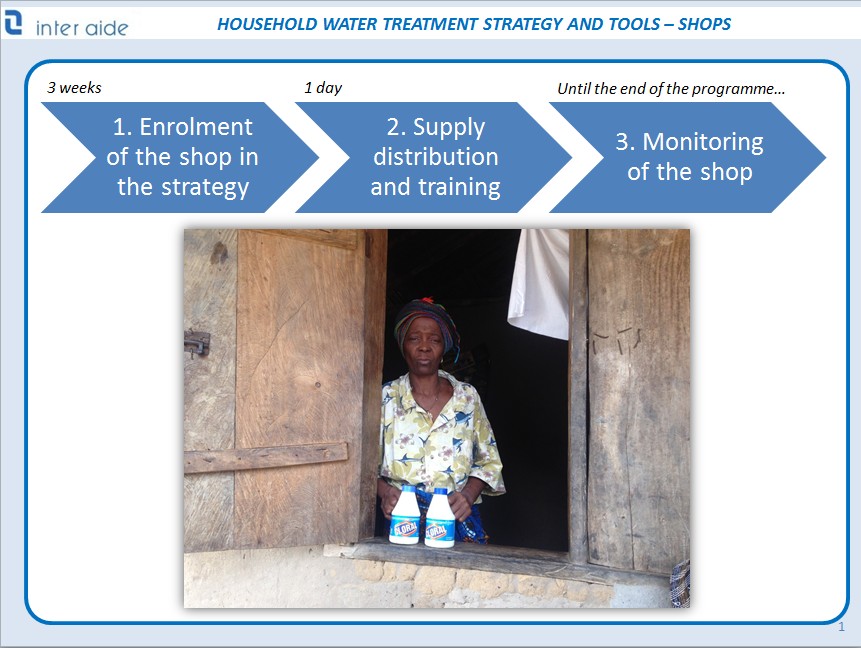
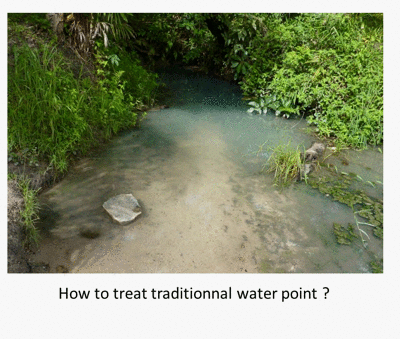

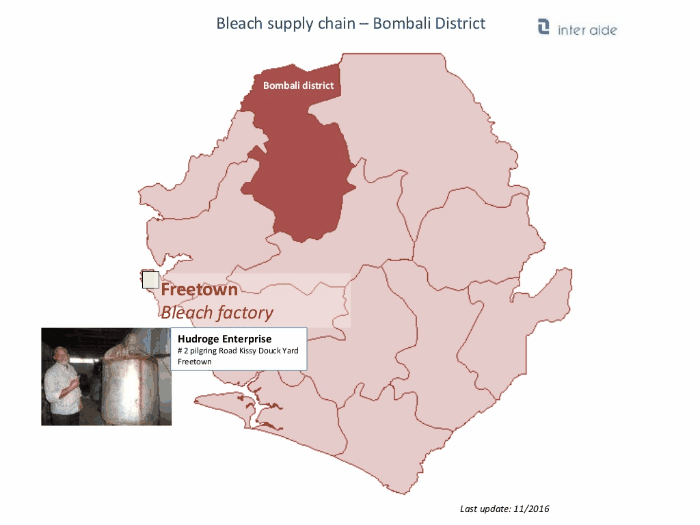
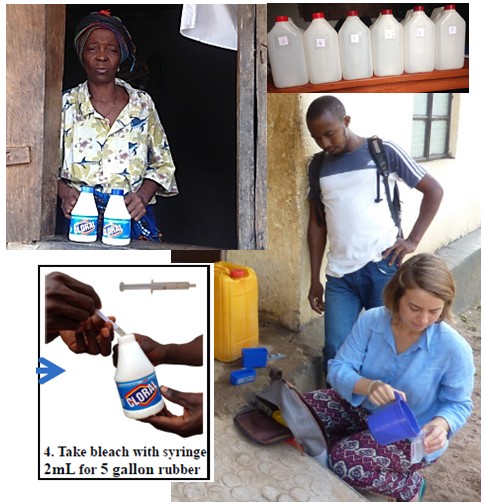 A specific study was done for 6 months in 2016 with a student – Aurélie Moy – to have a better understanding of the behave of the villagers toward household chlorination:
A specific study was done for 6 months in 2016 with a student – Aurélie Moy – to have a better understanding of the behave of the villagers toward household chlorination: